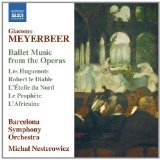|
Back
04/28/2014
Giacomo Meyerbeer: Ballet selections from the operas ‘Les Huguenots’ – 'Robert le diable’ – ‘L’Etoile du nord’ – ‘Le Prophète’ – ‘L’Africaine’
Barcelona Symphony Orchestra, Michał Nesterowicz (Conductor)
Recording: L’Auditori, Pau Casals Hall, Barcelona, Spain (July 3-6, 2012) - 69’ 38
Naxos # 8.573076 (Booklet in English)

   
The son of a wealthy Berlin family, Giacomo Meyerbeer would prove his biggest claim to be creations of grand opéra during the early to mid-19th century. This esteemed notion of creating an opéra-ballet began with Lully in the late 18th century which transformed itself into the uncompromising structuring of a five act opera including (normally) the ballet apportionment housed inside either the third or fourth act. Although initiated by Rossini’s Guillaume Tell (1828) and Auber’s La Muette di Portici (1829), it was Meyerbeer who would take ballet to yet another sophisticated and completely novel level.
Partially due to costs, but predominately rationalized as short-circuiting (in most cases but not all) the momentum of the opera’s plot (a divertissement), ballets are nowadays rarely incorporated in current productions. Furthermore, Meyerbeer’s music has, in recent times, been deemed ‘old-fashioned’ and out of vogue. This is why Michał Nesterowicz’s Barcelona Symphony Orchestra is to be lauded for having dedicated a sole album of ballet music extracted from Meyerbeer’s five grands opéras.
Nearly 50% of this Naxos recording is devoted to selections from Robert le diable (1831). In Robert the ballet truly renders purposeful structure within the storyline. Notable “Ballet des nonnes” (“Ballet of the Nuns”) has Nesterowicz closing in on the supernatural, demonic elements with brilliant imagery. The pas de cinq flounces with woodwinds and softened horns, a melodic pattern that one can indiscreetly hear in Meyerbeer’s ensuing opéra-comique, Dinorah (1859.) Additionally, the crescendo closing this clause anticipates Isabelle’s Act II concluding aria, “La trompette guerrière.”
Bassoons and horns do an exceptionally fine job in “The Procession” while staccato flutes chirp with sharpness in the subsequent “Bacchanale”; the closing measures (4:08) bring blushes of Herman Severin Løvenskiold’s La Sylphide (the 1836 Bournonville ballet version is directly associated with Robert) to mind. Piccolos’ mirrored mimicking of the flutes in an incisive, five-note rapid run hark back to Die Zauberflöte’s trademark Papageno theme found within the “Séduction par l’ivresse.” The “Séduction par le jeu” positions Nesterowicz’s violins in a nicely bouncy ¾ fashion. Demons surround and engulf the nuns’ souls in a tempestuous and sinister “Finale.”
In terms of Meyerbeer’s chronological sequence, “Danse bohémienne” is contained within his opera, Les Huguenots (1836), which appropriately opens the CD. The nearly five minute composition has much in terms of variant characterization and textural landscaping which adds a bit of reprieve ahead of the opera’s cataclysmic religious massacre.
Le Prophète premiered in 1849 and featured Meyerbeer’s score to innovative choreography using roller skates in the “Ballet of the Skaters.” Nesterowicz has plenty of energy behind the opening “Waltz” that’s quickly followed by the “Redowa” with majestic appeal. Horns hold their sustained B flat note beautifully in the second section of the movement. Ironically, the closing “Galop” just doesn’t appear to have sufficient steam to make the romp really rollick.
A plodding beat of the first note anchors a staidly pulse in L’Etoile du nord’s (1849) “Waltz”, but, again, Nesterowicz’s tempo seems a tad torpid (compare to Richard Bonynge’s 2009 recording with the National Philharmonic Orchestra featuring cowbells in the second section.) Nesterowicz paints the remaining selections with a colorful yet conservative approach: flavorful but not overtly ebullient.
Nesterowicz appears to regain his momentum in the closing piece, “Marche indienne” from Meyerbeer’s posthumous work, L’Africaine. Filled with plenty of moments for individual instruments to show their musical glory, the composition is exotic, spicy and rhythmically all over the board. The Barcelona Symphony Orchestra breathes a sense of zestful hopping back and forth from march like tempo to dance filled cadences. A snare drum subtly yet abruptly initiates the (6:30) closing measures gathering strength by filling the airways with marvelous jumps from instrument to instrument. All ends in a momentous surge of quasi Britannic royal pomp. A great way to close the Naxos recording.
Ballet music has its own sense of direction, movement and dialogue, helping lay out the choreographic footwork for dancers who take to the floor within the elaborate realm of French grand opéra. Michał Nesterowicz leads a fine interpretation of this highly specialized music.
Christie Grimstad
|